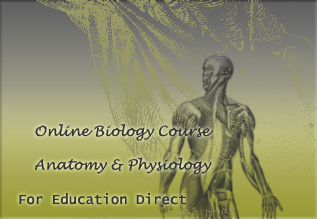Excerpts from Anatomy and Physiology I (Online Course) for Thompson Education Direct, USA
Course Description (3 credits)
 Anatomy and Physiology 1 provides an introduction to the
structure and function of the human body using a body systems approach.
Fundamental principles of cell, tissue and organ biology and chemistry are
explored in the context of balance and homeostasis. Special emphasis is placed
on the integumentary, skeletal, muscular and joint, nervous, sensory, endocrine
and blood systems.
Anatomy and Physiology 1 provides an introduction to the
structure and function of the human body using a body systems approach.
Fundamental principles of cell, tissue and organ biology and chemistry are
explored in the context of balance and homeostasis. Special emphasis is placed
on the integumentary, skeletal, muscular and joint, nervous, sensory, endocrine
and blood systems.
Learning Objectives/Outcomes
A student who successfully completes the course will have reliably demonstrated the ability to:
· Identify the basic anatomical structures of the human body.
· Describe the physiological functions of the human body systems.
· Analyze and discuss the levels of organization of the human body in order of increasing complexity.
· Describe the major organ systems of the human body.
· Synthesize similarities between different body systems.
· Analyze the process and mechanics of homeostasis.
· Explain how human anatomy and physiology are related.
· Identify the levels of structural organization that make up the human body and explain how they are related.
· Demonstrate effective online communication skills using discussion boards and e-mail.
· Identify and locate appropriate resources to research selected topics.
· Demonstrate appropriate analytical and synthesis cognitive skills.
SCREEN 3
Physiological Processes
Metabolism - is the complex functions within all of the body’s cells that lead to growth, secretion, repair, energy release, use of food, and breakdown of wastes at a cellular level.
Two major processes occur during metabolism, anabolism and catabolism.
Anabolism – involves the use of energy to build complex molecules and structures from simpler food and cellular components.
Catabolism – involves the release of energy from the breakdown of complex molecules to simpler components. The energy produced through catabolic processes is used to perform anabolic processes.
(Include diagram of anabolism and catabolism processes)
REVIEW QUIZ
- The structure that divides the thoracic cavity from the abdominopelvic cavity is the:
- mediastinum
- diaphragm
- lungs
- stomach
- The following is an example of a positive feedback loop:
- maintaining a constant body temperature
- contractions of the uterus during childbirth
- maintaining a constant volume of water in the body
- both a and c
Mix and Match
Match the following Tissues with the Primary Function
|
1. Epithelial Tissue |
A. Found in Urinary Bladder |
|
2. Muscle Tissue |
B. Most abundant tissue in body |
|
3. Stratified Transitional Epithelium |
C. Lines the trachea |
|
4. Connective Tissue |
D. Also known as body fat |
|
5. Nervous Tissue |
E. Covers the external body |
|
6. Adipose Connective Tissue |
F. Muscles that attach to Bone |
|
7. Connective Tissue with Liquid Matrix |
G. Muscle Tissue that contracts heart |
|
8. Skeletal Muscle Tissue |
H. Blood |
|
9. Striated Involuntary Cardiac Tissue |
I. Often forms scar tissue |
|
10. Pseudostratified Epithelium |
J. Consists of neurons and glia |
SCREEN 5
Discussion Forum # 3
Consider the structure and tissues in the skeletal, cardiac and visceral muscles. Visualize how the various structures support the unique functions of each muscle type. Post your insights about how the structures influence the functions in the Discussion Forum.
SCREEN 2
Muscle Movement and Exercise
Some of the benefits of regular, properly done exercise include:
- Improved muscle strength, coordination and tone
- Better posture
- Efficient cardiac and lung function
- Less fatigue
- Improved digestion
- Reduced body fat
- Improved joint movement
- Stronger skeleton
________________________________________________________________________
Muscle Movement and Exercise
Your Exercise Notebook
Exercise experts suggest that the act of keeping an exercise notebook helps people to organize and evaluate their fitness progress. To start, find a medium sized lined notebook or binder with index tabs. Call it “My Fitness Log” or “My Exercise Notebook.”
Goals – Write down your long-term and short-term fitness goals. Write these goals to address the three components of balanced exercise: strength, endurance and flexibility.
A long-term goal might be, “Walk 3 miles, three times a week,” while a short-term goal might be, “Walk 1 mile, twice a week.”
Measurements – In a separate section, record your current statistics:
- Weight
- Body measurements: chest, waist, hips, thighs, calves, upper arm circumferences.
- Blood Pressure
- Cholesterol Levels
Update this section about every 90 days.
Personal Record – keep a record of the type, amount of time, and date of the exercises you do. Try to vary your activities to ensure you are working on a balance of strength, endurance, and flexibility. It is recommended that you include some stretching with any workout activity, both to warm-up before you begin and to cool-down at the end of your session.